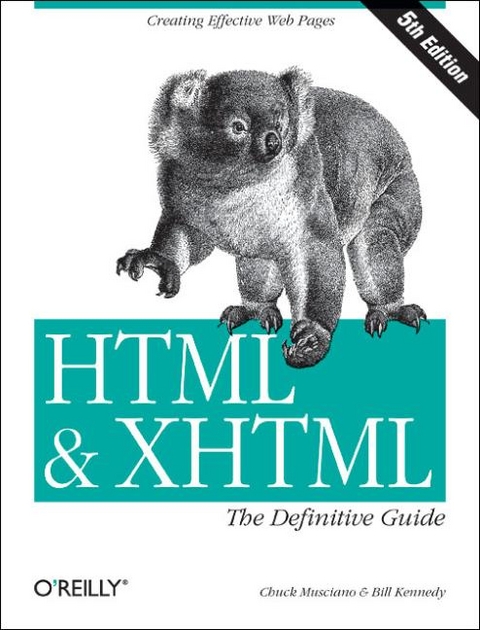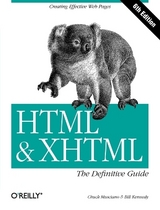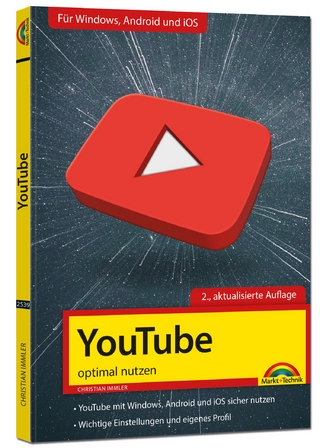
HTML and XHTML
O'Reilly Media (Verlag)
978-0-596-00382-1 (ISBN)
- Titel erscheint in neuer Auflage
- Artikel merken
This volume contains everything you'll need in order to create functional cross-platform Web applications. The new edition has been updated to cover the latest specifications, including HTML 4.01, CSS Level 2, DOM Level 2, and JavaScript 1.5, as well as the latest browsers, Internet Explorer 6 (Windows), Internet Explorer 5.1 (Mac), Netscape Navigator 6 and 7, and Mozilla 1.0. You'll learn how these standards and technologies relate to one another and how the creation of Dynamic HTML content relies on these four technologies. The book includes: a complete reference for all of the HTML tags, CSS style attributes, document object model attributes, methods, and event handlers, and core JavaScript objects supported by the various standards and the latest versions of Netscape and Internet Explorer. Cross-referenced indexes that make it easy to find interrelated HTML tags, style attributes, and document object model methods, attributes, and event handlers. An advanced introduction to creating dynamic Web content that addresses the cross-platform compromises inherent in Web page design today and encourages developers to adopt the W3C standards. If you have experience with basic Web page c
Chuck Musciano has spent his life on the East Coast, having spent time in Maryland, Georgia, and New Jersey before acquiring a B.S. in computer science from Georgia Tech in 1982. Since then, he has resided in Melbourne, Florida, in the employ of Harris Corporation. He began his career as a compiler writer and crafter of tools and went on to join Harris' Advanced Technology Group to help develop large-scale multiprocessors. This led to a prolonged interest in user-interface research and development, which finally gave way to his current position, manager of UNIX Systems in Harris' Corporate Data Center. Along the way, he grew to know and love the Internet, having contributed a number of publicly available tools to the Net and started the still-running Internet Movie Ratings Report. The Web was a natural next step, and he has been running various Web sites within and without Harris for several years. Chuck has written on UNIX-related topics in the trade press for the past decade, most visibly as the "Webmaster" columnist for Sunworld Online (http://www.sun.com/sunworldonline). In his spare time he enjoys life in Florida with his wife Cindy, daughter Courtney, and son Cole. Bill Kennedy is currently president and chief technical officer of ActivMedia, Inc., a new media marketing and marketing research company based in beautiful Peterborough, NH, but which conducts business with clients and associates from around the world primarily over the Internet (http://www.activmedia.com). When not hacking new HTML pages or writing about them, "Dr. Bill" (Ph.D. in biophysics from Loyola University of Chicago, of all things!) is out promoting a line of mobile, autonomous robots as real-world platforms for artificial intelligence and fuzzy logic research and for education (http://www.rwii.com). Or he's out drumming up writing assignments from his former colleagues at IDG's SunWorld/Advanced Systems Magazine (now SunWorld Online; http://www.sun.com), where he served as a senior editor-features (at-large over the Internet, of course) for nearly five years. Contact Dr. Bill directly at bkennedy@activmedia.com.
Preface 1. HTML, XHTML, and the World Wide Web 1.1 The Internet 1.2 Talking the Internet Talk 1.3 HTML and XHTML: What They Are 1.4 HTML and XHTML: What They Aren't 1.5 Standards and Extensions 1.6 Tools for the Web Designer 2. Quick Start 2.1 Writing Tools 2.2 A First HTML Document 2.3 Embedded Tags 2.4 HTML Skeleton 2.5 The Flesh on an HTML or XHTML Document 2.6 Text 2.7 Hyperlinks 2.8 Images Are Special 2.9 Lists, Searchable Documents, and Forms 2.10 Tables 2.11 Frames 2.12 Style Sheets and JavaScript 2.13 Forging Ahead 3. Anatomy of an HTML Document 3.1 Appearances Can Deceive 3.2 Structure of an HTML Document 3.3 Tags and Attributes 3.4 Well-Formed Documents and XHTML 3.5 Document Content 3.6 HTML/XHTML Document Elements 3.7 The Document Header 3.8 The Document Body 3.9 Editorial Markup 3.10 The 'bdo' Tag 4. Text Basics 4.1 Divisions and Paragraphs 4.2 Headings 4.3 Changing Text Appearance and Meaning 4.4 Content-Based Style Tags 4.5 Physical Style Tags 4.6 Precise Spacing and Layout 4.7 Block Quotes 4.8 Addresses 4.9 Special Character Encoding 4.10 HTML's Obsolete Expanded Font Handling 5. Rules, Images, and Multimedia 5.1 Horizontal Rules 5.2 Inserting Images in Your Documents 5.3 Document Colors and Background Images 5.4 Background Audio 5.5 Animated Text 5.6 Other Multimedia Content 6. Links and Webs 6.1 Hypertext Basics 6.2 Referencing Documents: The URL 6.3 Creating Hyperlinks 6.4 Creating Effective Links 6.5 Mouse-Sensitive Images 6.6 Creating Searchable Documents 6.7 Relationships 6.8 Supporting Document Automation 7. Formatted Lists 7.1 Unordered Lists 7.2 Ordered Lists 7.3 The 'li' Tag 7.4 Nesting Lists 7.5 Definition Lists 7.6 Appropriate List Usage 7.7 Directory Lists 7.8 Menu Lists 8. Cascading Style Sheets 8.1 The Elements of Styles 8.2 Style Syntax 8.3 Style Classes 8.4 Style Properties 8.5 Tagless Styles: The 'span' Tag 8.6 Applying Styles to Documents 9. Forms 9.1 Form Fundamentals 9.2 The 'form' Tag 9.3 A Simple Form Example 9.4 Using Email to Collect Form Data 9.5 The 'input' Tag 9.6 The 'button' Tag 9.7 Multiline Text Areas 9.8 Multiple Choice Elements 9.9 General Form-Control Attributes 9.10 Labeling and Grouping Form Elements 9.11 Creating Effective Forms 9.12 Forms Programming 10. Tables 10.1 The Standard Table Model 10.2 Basic Table Tags 10.3 Advanced Table Tags 10.4 Beyond Ordinary Tables 11. Frames 11.1 An Overview of Frames 11.2 Frame Tags 11.3 Frame Layout 11.4 Frame Contents 11.5 The 'noframes' Tag 11.6 Inline Frames 11.7 Named Frame or Window Targets 12. Executable Content 12.1 Applets and Objects 12.2 Embedded Content 12.3 JavaScript 12.4 JavaScript Style Sheets (Antiquated) 13. Dynamic Documents 13.1 An Overview of Dynamic Documents 13.2 Client-Pull Documents 13.3 Server -Push Documents 14. Netscape Layout Extensions 14.1 Creating Whitespace 14.2 Multicolumn Layout 14.3 Layers 15. XML 15.1 Languages and Metalanguages 15.2 Documents and DTDs 15.3 Understanding XML DTDs 15.4 Element Grammar 15.5 Element Attributes 15.6 Conditional Sections 15.7 Building an XML DTD 15.8 Using XML 16. XHTML 16.1 Why XHTML? 16.2 Creating XHTML Documents 16.3 HTML Versus XHTML 16.4 XHTML 1.1 16.5 Should You Use XHTML? 17. Tips, Tricks, and Hacks 17.1 Top of the Tips 17.2 Cleaning Up After Your HTML Editor 17.3 Tricks with Tables 17.4 Transparent Images 17.5 Tricks with Windows and Frames A. HTML Grammar B. HTML/XHTML Tag Quick Reference C. Cascading Style Sheet Properties Quick Reference D. The HTML 4.01 DTD E. The XHTML 1.0 DTD F. Character Entities G. Color Names and Values Index
| Erscheint lt. Verlag | 1.10.2002 |
|---|---|
| Zusatzinfo | index |
| Verlagsort | Sebastopol |
| Sprache | englisch |
| Maße | 179 x 232 mm |
| Gewicht | 964 g |
| Einbandart | kartoniert |
| Themenwelt | Mathematik / Informatik ► Informatik ► Web / Internet |
| ISBN-10 | 0-596-00382-X / 059600382X |
| ISBN-13 | 978-0-596-00382-1 / 9780596003821 |
| Zustand | Neuware |
| Haben Sie eine Frage zum Produkt? |
aus dem Bereich



